
Dr. Stevenson opened with a discussion of error. Computers havea very limited set of values they can represent, leaving a finite set in place of the real number continuum. There is a finite gap between computer-representable numbers, machine epsilon, a largest number lambda, and a smallest number sigma. All these depend on the particular computer, and all three cause 'schoolbook mathematics' not to work. They contribute to approximation error, perturbation error, and rounding error. There is also human error, which is usually more important and relevant to why a model does not produce the expected result. Dr. Warner described the Wilkinson model of what numbers can be represented on a computer. Lambda and sigma, he said, can be computed from epsilon. He laid out a list of real number axioms. Closure and associativity fail under addition and multiplication; the multiplicative inverse is lost. Distributivity, and therefore algebraic manipulation, also fails. However, the relative error is not usually large. The result one gets is the exact right answer to the wrong question, participants were told, or the right question perturbed slightly. In some cases, like weather forecasting, these small perturbations in the question can make the final result significantly, even qualitatively, different. Dr. Warner demonstrated a Java applet showing an RPN calculator to illustrate error in distributed multiplication. Dr. Panoff reiterated that measurement and human error is usually larger; the straws had 20% error in some cases.
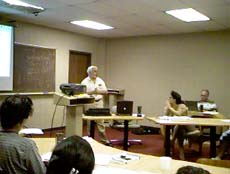 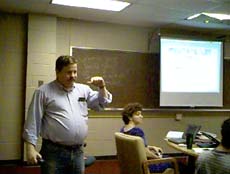 Returning from a coffee break, participants were challenged to "stand up and count from ten to one backwards." Some participants stood, turned around, and counted "one, two, three..." while others counted "ten, nine, eight...". Others said the counting itself was backwards, but disagreed also about whether up or down constituted backwards. "Who said we have to use the integers?" asked one. "Ten, nine point nine, nine point eight..." Dr. Panoff recited, "Net, enin, thgie, neves..." for his own example. An intern counted "Ten, nine, eight..." and then stood up. Dr. Hirst returned to a discussion of throwing snowballs, presenting a flowchart. "Why did I show you this diagram?" she asked. "If I weren't mathematically inclined, wouldn't it be easier for me to see what was going on?" That's what Stella does, she explained. 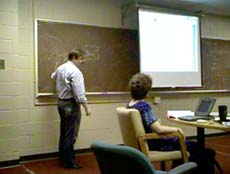 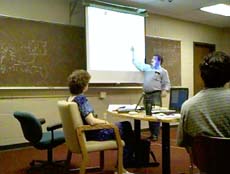 While Stella's graphing capabilities were limited, the suggestion was made that students could copy and paste tables of values into a superior graphing program.  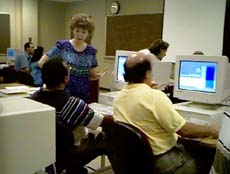 After lunch, participants began to experiment on their own with Stella. They began by recreating simple models suggested by Shodor staff, then moved on to creating more complicated models of their own. Returning to the lecture room, Dr. Panoff discussed how changing step size and integration methods can improve the accuracy of a continuous differential equation model. He showed how to easily run a sensitivity analysis in Stella, graphing several copies of the same model with, for example, a constant changed. He also demonstrated Stella's "flight simulator" mode, which allows real-time control of such variables and constants. Last Update: June 11, 1998 Please direct questions and comments about this page to WebMaster@shodor.org © Copyright 1998 The Shodor Education Foundation, Inc. |